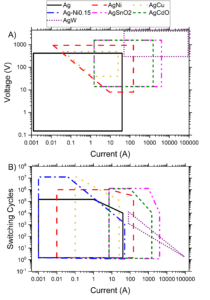Issue 037, June 10, 2022
Grant Justice, Sr. Research Metallurgist
Contacts used in circuits powerful enough to create an electrical arc need to provide a repeatable low contact resistance when closed and open on demand to break the circuit. Operating in an arcing regime presents additional difficulties in maintaining these key performance criteria, as electrical arcs will occur during contact closing and opening, affecting the contact surface with each cycle. Arcs that form during closing cause localized melting of the material that may cause the contacts to weld shut, making them more difficult to re-open. Opening arcs tend to last longer and cause more erosion to the contact surface eventually degrading the contact to the point where it can no longer achieve low contact resistance when closed. Various materials have been designed over the years to increase the arc resistance of contacts. However, these materials have drawbacks in terms of cost and ideal performance as seen in Figure 1. This article will broadly discuss the material options and how to make initial selections of arcing contact materials.

Figure 1: General comparison of cost performance trade-offs of silver-based electrical contact materials.¹,²
Fine Silver is used due to its high conductivity, ~108 %IACS, and its resistance to oxidation in air compared to copper. This combination of high conductivity and oxidation resistance maintains a low contact resistance for the switch.
Silver Alloys have slightly improved erosion and weld resistance compared to pure silver with some tradeoffs that vary by alloy. They can be used in slightly higher energy environments, or when higher reliability is required. One interesting note for silver alloy systems is the two distinct classes of silver – nickel alloys, the first is a cast alloy near the maximum solubility of nickel in silver of 0.15wt.%, the second is a composite of silver and nickel phases produced though a powder metallurgy process.
Silver – Metal Oxide Composites. The addition of metal oxides, historically cadmium oxide but more recently tin oxide, to the contact offers significantly decreased tendency to weld and increased resistance to arc erosion. The addition of the oxide phase makes these materials harder to process and fabricate into a final assembly. A fraction of non-conductive oxide on the surface also results in higher contact resistance.
Silver – Refractory Composites. The addition of the high melting point materials such as tungsten and/or tungsten carbide, molybdenum, or carbon add the greatest amount of weld resistance and arc erosion resistance to the final contact at the cost of higher contact resistance compared to the other potential contact materials. Additionally, the fabrication of high quality contacts out of these materials is a complex process with higher costs compared to the other material combinations.
One place to start to identify the best material for a desired application are the charts in Figure 2. First, compare the application’s current and voltage loads to Figure 2A and identify potential contact materials. Use the worst condition such as a motor starting load or short circuit current for safety critical applications such as circuit breakers. To understand the reliability tradeoffs of the different materials, refer to Figure 2B. These data are only a place to start, as they do not take into account the design of the switch.
A large number of factors in the switch design will also strongly influence the performance and reliability of a contact. Optimized mechanical designs that limit contact bounce on closing can significantly reduce the degree of contact welding that occurs and reduce the force required to break the welds. Contact features such as arc runners can quickly shift opening arcs off the contact face and greatly reduce arc erosion of the contact improving contact life. Deringer-Ney has many decades of experience with fabrication of contact assemblies from all the silver, silver alloy, and silver – metal oxide materials discussed. DNI now also provides a line of premium silver – refractory contacts under the Hoyt PowerMet brand for use in demanding applications.

Figure 2: Operating ranges for various silver based contact materials. AgNi represents composites of silver and nickel over the solubility limit vs the Ag-Ni0.15 that is a single-phase material near the maximum solubility of nickel in silver.³,⁴
References:
1. Lindmayer, M “Medium to High Current Switching: Low Voltage Contactors and Circuit Breakers, and
Vacuum Interrupters.” Electrical Contacts: Principles and Applications, edited by Slade, P CRC press,
2017.pp. 785-848
2. “Powder Metallurgy Electrical Contact Materials” ASM Handbook Vol. 7: Powder Metallurgy. Edited
by Samal, P. K., and J. W. Newkirk. ASM International (2015)
3. McBride, J 2021, 4 Day Intensive Course on Electrical Contacts – Switching Contacts, lecture notes,
Holm Conference, 23 Oct. 2021
4. Witter, G “Arcing Contact Materials” Electrical Contacts: Principles and Applications, edited by Slade,
Paul G. CRC press, 2017.pp. 879-952
